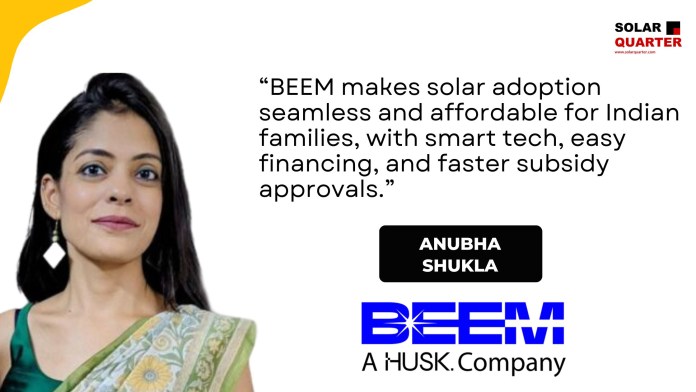
How is the PM Surya Ghar Yojana impacting the residential rooftop solar market in India?

The scheme has supercharged the entire ecosystem. Households are coming forward in large numbers, drawn by upfront subsidies and the promise of free electricity. Nodal agencies are now obligated only to expedite net metering and approvals, while banks are beginning to show real interest in financing. Furthermore, the DCR requirements are also giving a strong push to domestic manufacturing, though we expect substantial supply-side momentum to build over the next 12 to 18 months. Overall, the scheme has created a sense of urgency and alignment across stakeholders from consumers to regulators to financiers.
What key challenges hinder residential solar growth, and what scalable solutions can address them?

System-level quality is still a blind spot. While modules and inverters are monitored, other critical components like wiring, mounting structures, and overall workmanship often go unchecked and highlight a major gap in system-level quality. There’s no mandatory installer certification, and little clarity around system upgrades or replacements. These gaps persist due to low consumer awareness, limited financing options especially for households with informal incomes and a fragmented installer ecosystem with poor after-sales service. The way forward is in certifying installers, digitizing end-to-end project data, simplifying policy frameworks, and expanding access to vendor-neutral, tech-enabled financing solutions.
How can residential solar drive job creation while supporting national energy goals?
Residential solar is already contributing to job creation while advancing India’s national energy goals. Under the PM Surya Ghar Yojana, thousands of installers, many of them trained Suryamitras—have been registered. According to CEEW-NRDC, rooftop solar generates about 24 job-years per megawatt, significantly more than utility-scale solar, due to its service-intensive nature. These are primarily local jobs spanning installation, maintenance, sales, and technical support. At scale, residential solar not only supports livelihoods but also helps build distributed generation capacity, directly contributing to India’s target of 500 gigawatts of non-fossil fuel energy that complements the grid.
Why is streamlining financing and subsidies vital, and how can private players support this effort?
Financing remains one of the biggest bottlenecks in scaling residential solar. There’s currently no standardized way to value rooftop systems or assess a household’s ability to repay especially for those with informal incomes. To drive adoption, solar needs to be positioned as a core home upgrade, not just a consumer gadget. Germany offers a strong model, having successfully integrated solar loans into home improvement financing through KfW. India needs a similar approach. Private players can play a pivotal role by bundling loans with installations, leveraging fintech tools to evaluate borrowers, and partnering with public schemes to reduce risk. Additionally, streamlining digital, direct-to-beneficiary subsidies will boost trust and accelerate adoption.
What sets BEEM apart in the rooftop solar space, and how does it align with India’s clean energy vision?
India’s rooftop solar market has long been held back by fragmented vendor networks, inconsistent quality, and a complex subsidy process. BEEM, launched by Husk Power Systems, was built to solve exactly these challenges. As India’s first fully productized residential solar solution, BEEM is pre-engineered, standardized, and tailored specifically for Indian households. Unlike traditional setups that rely on third-party vendors, BEEM offers a seamless, end-to-end experience. It combines Tier 1 solar modules, smart inverters, built-in safety features, and in-house installation to ensure consistent quality. The entire customer journey from system exploration to booking, financing, and subsidy tracking is digital, transparent, and user-friendly.
We are live in around 10 cities, and early installs are already seeing faster subsidy processing and approvals than the market norm.Fully aligned with the PM Surya Ghar Yojana, BEEM is helping accelerate the goal of powering 10 million homes by 2027. By reimagining the customer experience, BEEM is making clean energy adoption easier, faster, and truly scalable.
How is BEEM making solar affordable and accessible for families, and what market response have you seen?
BEEM addresses two of the biggest barriers to residential solar adoption i.e high upfront costs and process complexity. By offering pre-approved systems, in-app customer support, and access to low-interest financing, BEEM simplifies the entire journey. There’s no need to chase vendors or get stuck in paperwork, it’s a smooth, guided experience from the start.
Our flagship products, Aura and Eternia, are specifically designed for Indian rooftops, offering best-in-class safety, long-term warranties, and five years of zero-cost maintenance. Every system is registered on the National Portal and qualifies for subsidies of up to ₹78,000, which are transferred directly to the customer.
Our focus is on middle-income families in Tier 2 and Tier 3 cities—the segment that wants solar but hasn’t been served well. In cities like Lucknow, Dehradun, and Patna, BEEM customers are already reporting up to 90% reductions in electricity bills. The response has been overwhelmingly positive, with users highlighting how easy the digital onboarding process is and 90% of service issues resolved within 48 hours.
Related
